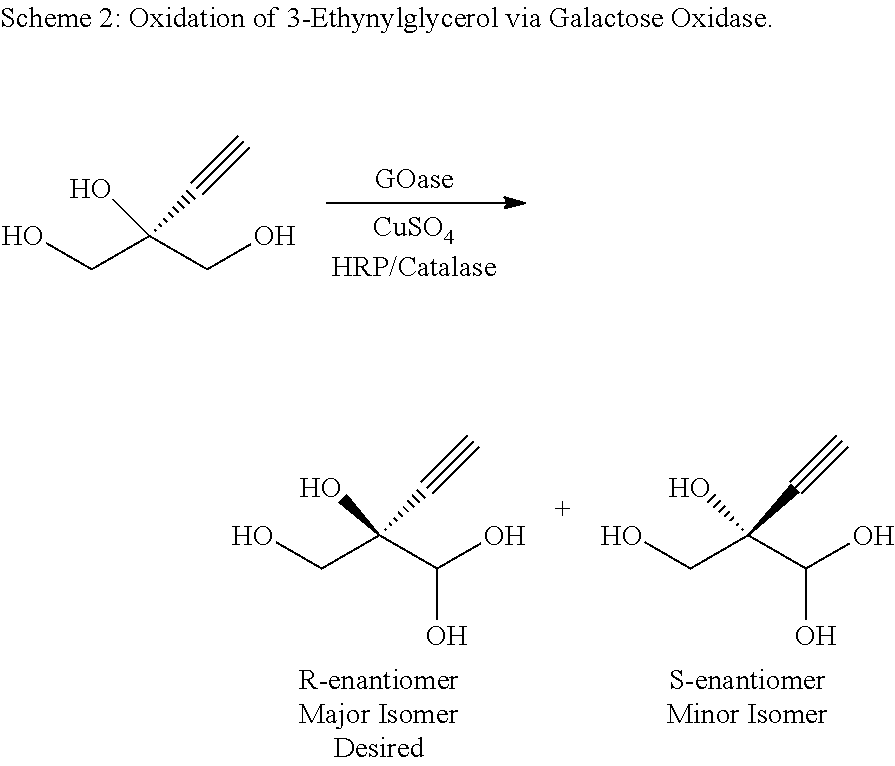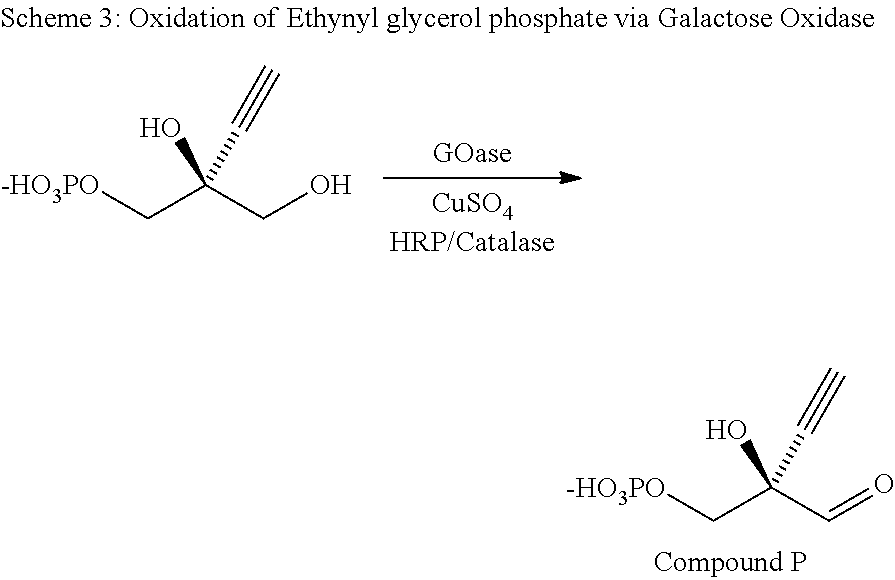Engineered galactose oxidase variant enzymes
a technology of galactose oxidase and variant enzymes, which is applied in the field of engineering galactose oxidase (goase) enzymes, polypeptides, can solve the problems of severe physical harm to personnel and property, difficult control of the method of oxidation in terms of oxidation state,
- Summary
- Abstract
- Description
- Claims
- Application Information
AI Technical Summary
Benefits of technology
Problems solved by technology
Method used
Image
Examples
example 1
GOA Improvements Over SEQ ID NO: 2 for Enantioselective Production of EGA
[0207]The parent genes for the GOA (SEQ ID NO: 2) enzyme used to produce the variants of the present invention were codon optimized for expression in E. coli and synthesized and cloned into the pET-30a vector. BL21(DE3) E. coli cells were transformed with the respective plasmid containing the GOA-encoding genes and plated on Luria broth (LB) agar plates containing 1% glucose and 50 μg / mL kanamycin (KAN), and grown overnight at 37° C. Monoclonal colonies were picked and inoculated into 180 μL LB containing 1% glucose and 50 μg / mL KAN 96-well shallow-well microtiter plates. The plates were sealed with O2-permeable seals and cultures were grown overnight at 30° C., 200 rpm and 85% relative humidity (RH). Then, 10 μL of each of the cell cultures were transferred into the wells of 96-well deep-well plates containing 390 μL TB, 50 μg / mL KAN and 0.5 mM CuSO4. The deep-well plates were sealed with O2-permeable seals an...
example 2
Preparation of Galactose Oxidase (GOA) Wet Cell Pellets
[0216]The parent genes for the GOA (SEQ ID NO: 2) enzyme used to produce the variants of the present invention were codon optimized for expression in E. coli and synthesized and cloned into a pCK900 vector (See e.g., U.S. Pat. No. 9,714,437, which is hereby incorporated by reference herein). W3110 E. coli cells were transformed with the respective plasmid containing the GOA-encoding genes and plated on LB) agar plates containing 1% glucose and 30 μg / mL CAM, and grown overnight at 37° C. Monoclonal colonies were picked and inoculated into 180 μL LB containing 1% glucose and 30 μg / mL CAM in 96-well shallow-well microtiter plates. The plates were sealed with O2-permeable seals and cultures were grown overnight at 30° C., 200 rpm and 85% RH. Then, 10 μL of each of the cell cultures were transferred into the wells of 96-well deep-well plates containing 390 μL TB and 30 μg / mL CAM. The deep-well plates were sealed with 02-permeable sea...
example 3
Preparation of HTP GOA-Containing Cell Lysates
[0217]Frozen pellets prepared as specified in Example 2 were lysed with 400 μL lysis buffer containing 50 mM NaPi buffer, pH 7.4, 1 mg / mL lysozyme, 0.5 mg / mL PMBS. The lysis mixture was shaken at RT for 2 hours. The plate was then centrifuged for 15 min at 4000 rpm and 4° C. The supernatants were then used in biocatalytic reactions as clarified lysates, in experiments described below to determine the activity levels.
PUM
| Property | Measurement | Unit |
|---|---|---|
| pKa | aaaaa | aaaaa |
| temperature Tm | aaaaa | aaaaa |
| temperatures | aaaaa | aaaaa |
Abstract
Description
Claims
Application Information
 Login to View More
Login to View More - R&D
- Intellectual Property
- Life Sciences
- Materials
- Tech Scout
- Unparalleled Data Quality
- Higher Quality Content
- 60% Fewer Hallucinations
Browse by: Latest US Patents, China's latest patents, Technical Efficacy Thesaurus, Application Domain, Technology Topic, Popular Technical Reports.
© 2025 PatSnap. All rights reserved.Legal|Privacy policy|Modern Slavery Act Transparency Statement|Sitemap|About US| Contact US: help@patsnap.com



